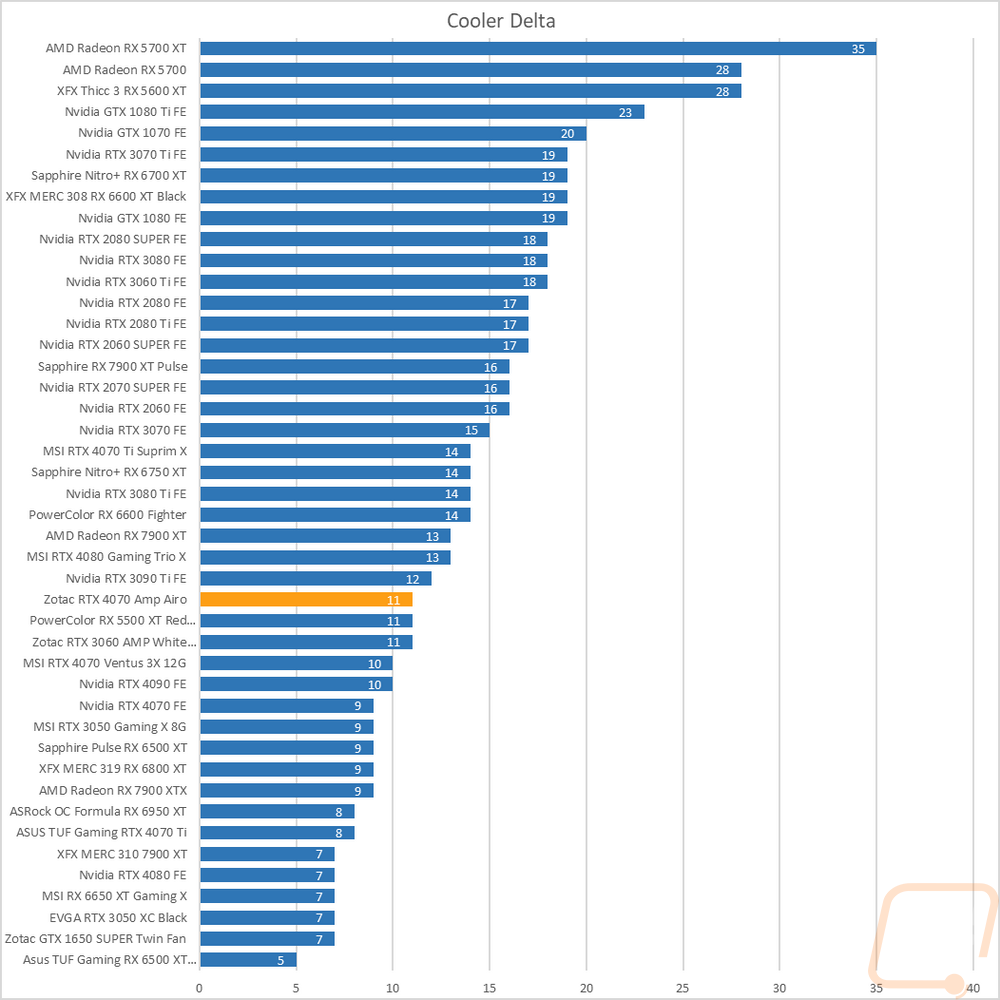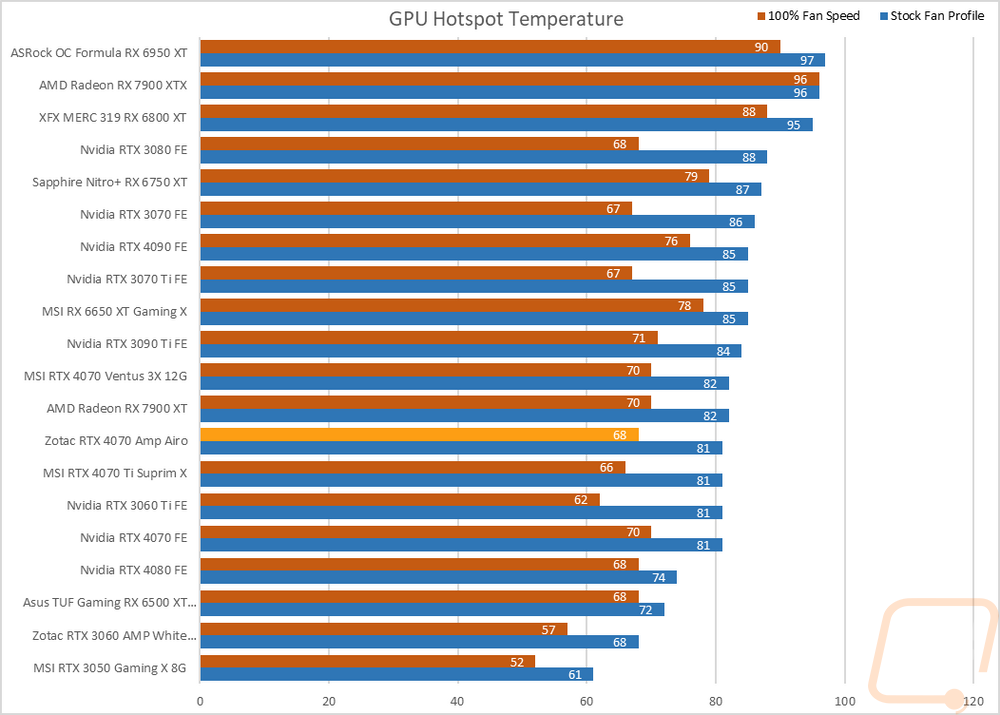Cooling Noise and Power
For my last few tests, rather than focusing on in game performance, I like to check out other aspects of video card performance. These are also the most important ways to differentiate the performance between cards that have the same GPU. To start things off I took a look at power usage.
For this, our new test setup utilizes the Nvidia-designed PCat v2 along with cables to handle both traditional 6 or 8-pin connections as well as the new 12VHPWR. The PCat also utilizes a PCIe adapter to measure any power going to the card through the PCIe slot so we can measure the video card wattage exclusively, not the entire system as we have done in the past. I test with a mix of applications to get both in game, synthetic benchmarks, and other workloads like Blender and AIDA64. Then everything is averaged together for our result. I also have the individual results for this specific card and I document the peak wattage results as well which is almost always Time Spy Extreme. The Zotac RTX 4070 Amp Airo surprised me here, with this being an overclocked card I was expecting it to have a more aggressive power profile like the Ventus did even while having a stock clock speed. The Zotac RTX 4070 Amp Airo on the other hand came in lower than the Founders Edition with its peak power but an impressive 12 watts putting it down below the 6650 XT for peak power. Its average power draw on the hand did increase, but only by 2 watts for 217 watts to the Founders Editions 215.


With having exact peak wattage numbers when running Time Spy Extreme I was also able to put together a graph showing the total score for each watt that a card draws which gives us an interesting look at overall power efficiency in the popular and demanding benchmark. Having a better Time Spy score than the Founders Edition 4070 and dropping its peak power the efficiency chart likes the Zotac RTX 4070 Amp Airo. The combination raised the score per watt from 33.74 to 36.06, pushing it up close to the RTX 4080’s score.

My next round of tests were looking at noise levels. These are especially important to me because I can’t stand to listen to my PC whirling. Especially when I’m not in game and other applications are using the GPU. For my testing, though I first tested with the fan cranked up to 100% to get an idea of how loud it can get, then again at 50% to get an idea of its range. The Zotac RTX 4070 Amp Airo came in at 39.7 db for its 50% fan speed result which was tied with the 4070 Founders Edition but its 100% fan speed noise levels were higher at 60.9 which isn’t a big surprise given it having three fans. The fan speeds weren’t as far up the chart which shows they are a little noisy compared to the RPM. I also take a look at noise performance while under load. For that when running AIDA64’s stress test I wait until the temperature of the card has leveled off and then measure how loud things are when the card is at its worst-case scenario with the stock fan profile. Here the Zotac RTX 4070 Amp Airo is at the bottom of the chart which is impressive. When under load over an extended period of time the fans settled at just 35% which avoided the noise that they can make when cranked up. Add to that having the fans turn off when under light load and the Zotac RTX 4070 Amp Airo is extremely quiet in actual use.





To finish up my testing I of course had to check out the cooling performance. To do this I ran two different tests. I used AIDA64’s Stress Test run for a half-hour each to warm things up. Then I documented what temperature the GPU leveled out at with the stock fan profile and then again with the fans cranked up to 100%. With the stock profile, the Zotac RTX 4070 Amp Airo leveled off at 63c. For comparison, the 4070 Founders Edition did the same test at 64c and the stock-clocked MSI 4070 Ventus with its triple fan cooler was 65c making the Zotac RTX 4070 Amp Airo the lowest of the three. This is even more impressive when we also figure in how quiet the card was when under load which we just saw above. Then with the fans cranked up, the Zotac RTX 4070 Amp Airo dropped down to 52c for a delta of 11 between the two meaning there is room still left for more cooling if needed. But Zotac did a great job with the stock fan profile. For comparison at 100% fan speed, both of the other RTX 4070s ran at 55c which is 3 degrees higher than the Amp Airo.



While doing the stock profile and 100% fan speed thermal tests I did also note the GPU Hotspot and Memory temperatures as well. The Zotac RTX 4070 Amp Airo came in at 81c with the stock profile for the hotspot and 68c with the fans at 100%. This was 2c less than the Founders Edition at 100% fan speed but they tied with the stock fan profile. The Ventus on the other hand was at 70c and 82c which was higher on both. The memory temperature chart is a little smaller, none of the AMD cards have memory temp sensors, and only the higher-end 3000 Series Nvidia cards have had them as well. But the Zotac RTX 4070 Amp Airo and the 4070 Founders Edition tied here at 42c for the 100% fan speed and 56c for the stock profile, both running nice and cool.


While running the stock fan profile testing I also took the time to get a few thermal images so we could see what is going on. The thermal images of the 4070 Amp Airo show the hottest areas are actually up under the card. The fan side was running extremely cool even through the fans on the heatsink with the hottest spots on the bottom half of the first two fans. The top edge does have some heat up on the PCB which is the hottest spot at 45.8c and some heat down past the power connection with the exposed heatsink but nothing not like our MSI 4070. The back of the card shows the metal backplate working and transferring the heat out. You can also see that the blow-through fan section at the end is cooling things down well. The hottest spot here is again above the GPU on the top edge which from this angle is showing 53.2c in the heatsink there.





